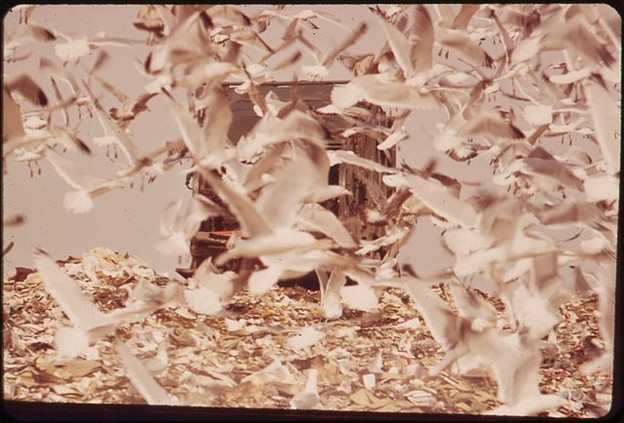Eight million natures

Today I took a bike ride along the East River to the Brooklyn Bridge where there’s a small beach--perhaps the only one in lower Manhattan (and by “lower,” I suspect there may be another beach somewhere or nowhere above the George Washington Bridge). There I watched a drama peculiar to urban ecologies. Several seagulls fought over what looked like a cupcake wrapper, with one finally grasping it in its beak and flying around to escape (without any luck) the other seagulls trying to snatch it back. I wondered how the seagull was going to enjoy his booty when he began gulping the wrapper down, one crinkle at a time, paper along with crumbs.
Back in the ground action, another seagull busied itself dragging empty plastic bags out of the surf and defending these useless bits of garbage against other seagulls, puffing its feathers up and hunching down. It finally found a bag that had two oranges in it and pecked a bit, but seemed to find the defensive act much more interesting. I looked at the surf to see what else the seagull would find, but I only saw what appeared to be the disintegrated pieces of an entire newspaper floating in and out on the small waves. Of course, in the city, you are never the only witness--a man stood a few feet away from me, snapping photo after photo (he was there when I arrived and stayed after I left) of the scene. (I should mention here that the poet Brenda Coultas once made an amazing film of seagulls eating french fries.)
So why do I write about this? It’s undoubtedly disgusting, watching wild animals fight over plastic and salt-soaked newspaper (with seasoning of PCBs and dioxins, no doubt). And pathetic, that even this tiny bit of open space could evoke "beach" with the sound of the seagulls and the tiny waves breaking on the beer can-strewn shore--if I closed my eyes and tuned out the sound of the traffic on the FDR. Men stood on either side, fishing. Some may eat the fish. Some may sell it. I met one father and son who had caught a huge fish that they said would go for hundreds of dollars in China, and at least $20 in Chinatown. But this under-the-bridge urban ecology has it all--conflict and negotiations, fascinating extremity of debris and disgust, recycling (cupcake wrapper into gullet), observer(s)/naturalist(s)/voyeur(s). It’s an urban ecology of which I am a part, and not exterior or extraneous to it. It wasn't a particularly transcendental bit of nature, but it was nature, a chaotic nature more "real" than carefully curated zoo or botanical garden. A nature that showed where wild accommodates human, an undomesticated nature within the supposed center of domesticity, a nature with responsibility. I could see the end results of action and existence. I could see the rawness of nature with me and 8 million other mes squarely in it.
Geometries of landscape